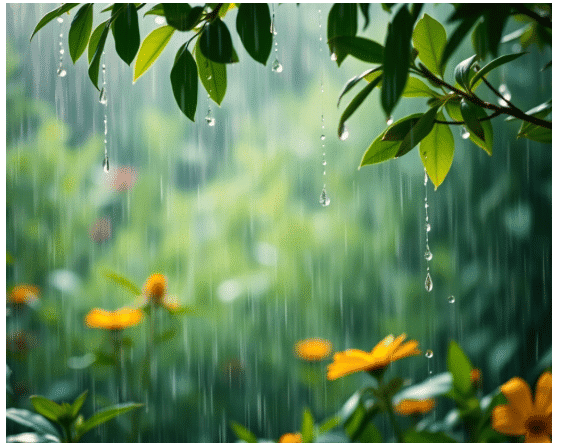Poem 3 - The Voice of the Rain Class 11 English Hornbill
| Table of contents |

|
| Introduction |

|
| Key Points of the Poem |

|
| Detailed Summary |

|
| Conclusion |

|
| Literary Devices |

|
| Difficult Words |

|
Introduction
The poem "The Voice of the Rain" by Walt Whitman is a beautiful conversation between the poet and the rain, where the rain personifies itself and explains its significance in the natural cycle. The poem highlights the cyclic journey of the rain—how it rises, transforms, and returns to its origin while purifying and nourishing the earth. Whitman draws a parallel between rain and music, emphasizing their shared qualities of renewal, rhythm, and connection to their origins.

Key Points of the Poem
- The poem begins with the poet questioning the rain about its identity. Surprisingly, the rain responds, introducing itself as the "Poem of Earth."
- The rain describes its journey, starting from evaporation, ascending invisibly from the land and sea to the sky, where it takes shape but remains essentially unchanged.
- It then returns to earth in the form of rain, purifying the environment, nourishing seeds, and enabling life to flourish.
- The rain compares its cyclic movement to that of a song, which originates from the soul, fulfills its purpose, and returns to its source, transformed yet unchanged.
- The poem concludes with the idea that both rain and music are eternal and nurturing forces, emphasizing their role in sustaining life and beautifying the world.
Detailed Summary
And who art thou? said I to the soft-falling shower,
Which, strange to tell, gave me an answer, as here translated:
I am the Poem of Earth, said the voice of the rain
Eternal I rise impalpable out of the land and the
bottomless sea,
The poet asks the soft-falling rain about its identity. To his surprise, the rain replies, describing itself as the "Poem of Earth." It explains that it continuously rises in the form of vapors from the land and the vast oceans. This process is eternal, highlighting the rain’s never-ending cycle as a natural force essential to life.
Upward to heaven, whence, vaguely form’d, altogether changed, and yet the same,
I descend to lave the droughts, atomies, dust-layers of the globe,
And all that in them without me were seeds only, latent, unborn;
The rain continues, explaining how it ascends to the sky as vapor, where it takes a different form by condensing into clouds. Although its appearance changes, its essence remains the same. The rain descends to the earth, washing away drought, dust, and impurities, and nourishing the land. It gives life to seeds buried in the earth, enabling them to sprout and grow, symbolizing its nurturing role in sustaining life.
And forever, by day and night, I give back life to my own origin,
And make pure and beautify it;
(For the song, issuing from its birth-place, after fulfillment, wandering
Reck’d or unreck’d, duly with love returns.)
The rain highlights its perpetual cycle, where it continuously enriches and purifies the earth, the very source from which it originated. It symbolizes renewal, as the rain enhances the beauty and purity of nature. The poet draws a comparison between the rain and a song. A song originates from the soul of a singer, fulfills its purpose by spreading joy or inspiration, and eventually returns to its origin. Similarly, the rain completes its cycle and returns to its source, whether appreciated (reck’d) or unnoticed (unreck’d), with love and fulfillment.
Conclusion
"The Voice of the Rain" by Walt Whitman is a celebration of nature’s cycles and the symbiotic relationship between the rain and the earth. The rain’s journey symbolizes renewal and continuity, showing how it sustains life and purifies the environment. By drawing a comparison between rain and music, the poet highlights their shared qualities of nurturing and returning to their origins. The poem’s personification of the rain and its lyrical quality make it a timeless reflection on the interconnectedness of life and nature.
Literary Devices
- Personification: The rain is personified, speaking of its journey and purpose as the "Poem of Earth."
- Metaphor: The rain refers to itself as the "Poem of Earth," symbolizing its role in nurturing life.
- Imagery: The poem uses vivid descriptions like "descend to lave the droughts, atomies, dust-layers" to create visual and sensory imagery.
- Parallelism: The rain’s cycle is paralleled with the journey of a song, emphasizing their eternal nature.
- Brackets: The poet uses brackets to reflect his personal musings, adding a reflective layer to the poem.
Difficult Words
- Whence – where
- Vaguely – not clearly
- Descend – come down
- Lave – wash; bathe
- Atomics – small particles
- Latent – hidden/buried
- Reck’d or unreck’d – whether cared for or not; it does not matter to the rain or the poet if anyone listens to the rain.
- Who art thou – Who are you
- Eternal – never-ending
- Impalpable – which cannot be described
|
72 videos|449 docs|80 tests
|
FAQs on Poem 3 - The Voice of the Rain Class 11 English Hornbill
| 1. What is the main theme of the poem "The Voice of the Rain"? |  |
| 2. Who is the speaker in the poem "The Voice of the Rain"? |  |
| 3. How does the rain impact the speaker in the poem? |  |
| 4. What literary devices are used in "The Voice of the Rain" to enhance its meaning? |  |
| 5. How does the rain symbolize emotions or feelings in the poem? |  |
















